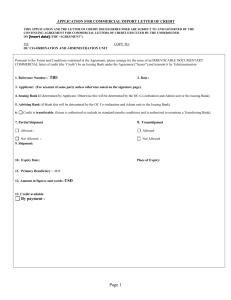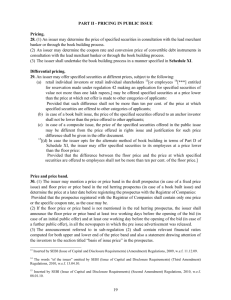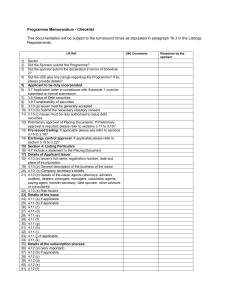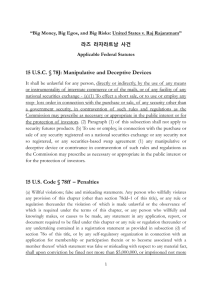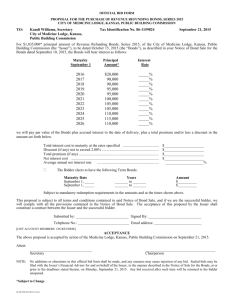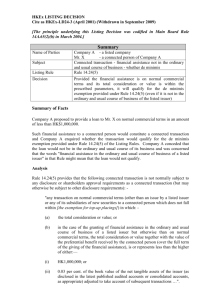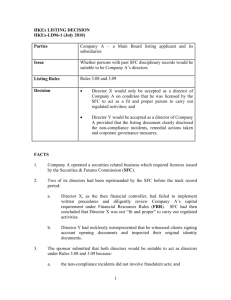Issue of Commercial Paper
advertisement
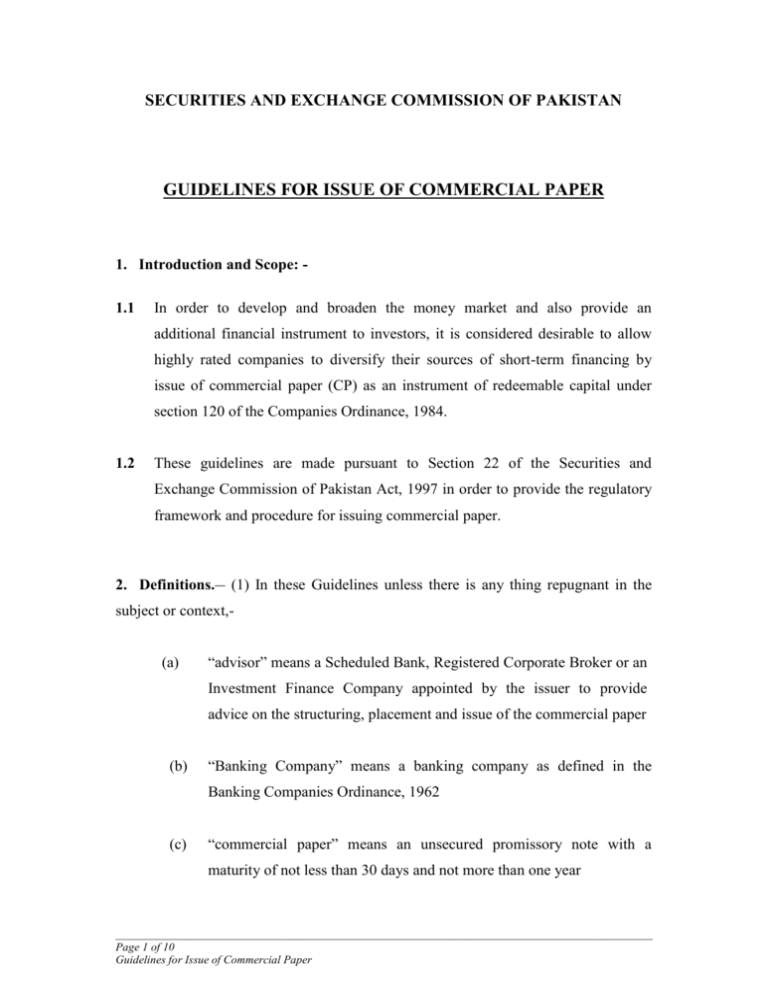
SECURITIES AND EXCHANGE COMMISSION OF PAKISTAN GUIDELINES FOR ISSUE OF COMMERCIAL PAPER 1. Introduction and Scope: 1.1 In order to develop and broaden the money market and also provide an additional financial instrument to investors, it is considered desirable to allow highly rated companies to diversify their sources of short-term financing by issue of commercial paper (CP) as an instrument of redeemable capital under section 120 of the Companies Ordinance, 1984. 1.2 These guidelines are made pursuant to Section 22 of the Securities and Exchange Commission of Pakistan Act, 1997 in order to provide the regulatory framework and procedure for issuing commercial paper. 2. Definitions.__ (1) In these Guidelines unless there is any thing repugnant in the subject or context,- (a) “advisor” means a Scheduled Bank, Registered Corporate Broker or an Investment Finance Company appointed by the issuer to provide advice on the structuring, placement and issue of the commercial paper (b) “Banking Company” means a banking company as defined in the Banking Companies Ordinance, 1962 (c) “commercial paper” means an unsecured promissory note with a maturity of not less than 30 days and not more than one year _____________________________________________________________________________________________ Page 1 of 10 Guidelines for Issue of Commercial Paper (d) “Commission” means the Securities and Exchange Commission of Pakistan (e) “company” means a company as defined in the Companies Ordinance, 1984 (f) “dealers” means Investment Finance Companies, Registered Corporate Broker or Banking Companies who buys commercial paper and resell to investors (g) “DFIs” means any institution as defined in State Bank of Pakistan’s (SBP’s) Guidelines on Commercial Paper or as subsequently defined by SBP from time to time (h) “financial institution” means a financial institution as defined in the Financial Institutions (Recovery of Finances) Ordinance, 2001 and the Companies Ordinance, 1984 (i) “Guidelines” means the Guidelines for Issue of Commercial Paper (j) “Investment Finance Company” means a company as defined under The Non-Banking Finance Companies (Establishment and Regulation) Rules, 2003 (k) “investors” means the initial investors or subsequent buyers of commercial paper in the secondary market (l) “issuer” means a company that intends to raise short-term finance by issuing commercial paper _____________________________________________________________________________________________ Page 2 of 10 Guidelines for Issue of Commercial Paper (m) “Issuing and Paying Agent (IPA)” means a Scheduled Bank, an Investment Finance Company or a DFI having a minimum Credit Rating Grade of “A-“ (medium to long term) and “A2” (short term) from any rating agency (n) “rating agency” means a Credit Rating Agency (CRA) registered with the Commission under the Credit Rating Companies Rules, 1995 (o) “Registered Corporate Broker” means a company engaged in the business of effecting transactions in securities for the account of others and registered with the Commission under Brokers and Agents Registration Rules, 2001 (p) “Scheduled Bank” means a scheduled bank as defined in the State Bank of Pakistan Act 1956 (q) “working capital limit” means the aggregate fund-based limits including those by way of purchase/discount of bills sanctioned by one or more financial institutions to a company for meeting its working capital requirements, and also includes any working capital term finance limits. (2) All other words and expressions used but not defined in these Guidelines shall have the same meanings as are assigned to them in the Companies Ordinance, 1984 (XLVII of 1984), the Securities and Exchange Ordinance, 1969 (XVII of 1969) and the Securities and Exchange Commission of Pakistan Act, 1997. 3. Eligibility for issue of commercial paper A company, which satisfies the following requirements, shall be eligible to issue commercial paper subject to the terms and conditions contained in these Guidelines: _____________________________________________________________________________________________ Page 3 of 10 Guidelines for Issue of Commercial Paper (a) The equity of the company is not less than Rs. 100 million as per the latest audited balance sheet; (b) The company has obtained the credit rating from a rating agency. The minimum credit rating of the issuer shall be “A-” (medium to longterm) and “A2” (short-term). At the time of issue of commercial paper, the company shall ensure that the rating is current and not more than two months old; (c) The company should have no overdue loan or defaults in the report obtained from the Credit Information Bureau (CIB) of the State Bank of Pakistan (SBP), and the said report should not be more than two months old; and (d) As per the latest audited balance sheet, the company maintains a minimum current ratio of 1: 1 and debt/equity ratio of 60: 40. Explanation – For the purpose of this paragraph, “equity” shall mean the paid-up capital plus free reserves as defined in rule 5 of the Companies (Issue of Capital) Rules, 1996 minus accumulated losses as per the latest audited balance sheet of the company. 4. Minimum and maximum period of commercial paper (a) The commercial paper shall be issued for maturities between 30 days and one year from the date of subscription. (b) If the maturity date happens to be a holiday, the company shall be liable to make payment on the immediate following working day. (c) Commercial paper may be rolled over at maturity subject to the written consent of the investor(s) provided a clause to this effect is mentioned _____________________________________________________________________________________________ Page 4 of 10 Guidelines for Issue of Commercial Paper on the commercial paper and in the terms and conditions of the agreement under which the commercial paper has been issued and the issuer fulfills the requirement of clause 3 of the Guidelines at the time of roll over. Further, the issuer may redeem the commercial paper before maturity under the call option, if any, and the investor may ask the issuer for early redemption under the put option, if any. 5. Minimum size and Denomination of commercial paper (a) The minimum size of the issue of commercial paper shall not be less than Rs.10 million. (b) The commercial paper, in case of private placement, may be denominated in Rs. 100,000 (face value) or in multiples thereof and in case of offer to general public, may be denominated in Rs. 5,000 or in multiples thereof. 6. Ceiling on amount of issue of commercial paper The aggregate amount of commercial paper raised by an issuer shall be within the limit as provided by its Board of Directors in accordance with the prudential regulations or the quantum indicated by the rating agency for the specified rating, whichever is lower. 7. Mode of issue and discount rate The commercial paper shall be in the form of a promissory note and be issued at such discount to face value as may be determined by the issuer keeping in view the prevailing T-Bill rates, KIBOR and its Credit Rating. 8. Issuer expenses: A company issuing commercial paper shall bear the expenses of issue including the fees payable to the advisor, the issuing and paying agent, the dealers, the rating agency, and any other relevant charges connected with such issue _____________________________________________________________________________________________ Page 5 of 10 Guidelines for Issue of Commercial Paper 9. Investors in commercial paper Commercial paper may be issued by way of Public offer and/or to Scheduled Banks, Financial Institutions, and/or such other persons as are specified for this purpose by the Commission by notification in the official gazette under Section 120 of the Companies Ordinance, 1984. 10. Procedure for issue of commercial paper (a) The issuer may appoint an adviser for assistance on the structure and placement of the commercial paper issue. (b) The issuer, shall thereafter appoint an IPA and, dealers if so desired, for private placement/sale of the issue. (c) The commercial paper issue in case of private placement must be completed within a period of two weeks from the date on which the issuer opens the issue for subscription. Any unsold portion of the issue after two weeks of its opening for subscription shall not be issued. In case of public offer it should be completed within the period as specified in the Companies Ordinance, 1984. (d) The initial investors in commercial paper shall pay through the issuing and paying agent, the discounted value of the commercial paper by means of crossed account payee cheque to the account of the issuing company. (e) The issuer shall intimate in writing to all initial investors and all financial institutions, who have provided working capital limits to the company, about the amount and tenure of the commercial paper issue, and copies of such intimation should be provided to the issuing and paying agent. _____________________________________________________________________________________________ Page 6 of 10 Guidelines for Issue of Commercial Paper (f) The issuer shall intimate to the Commission, the amount of commercial paper actually issued, within three days of the closing of subscription list. 11. Role and Responsibilities The role and responsibilities of issuer, IPA and CRA are set out below: (a) Issuer The issuer shall ensure that the Guidelines and procedures laid down for commercial paper issuance are strictly adhered to. (b) Issuing and Paying Agent (IPA) (i) IPA shall ensure that issuer has the minimum credit rating as stipulated by the Commission and the quantum of amount raised through issuance of commercial paper is within the limit as disclosed in clause 3(b) and clause 6 respectively. (ii) IPA shall ensure that the issuer has met all the regulatory requirements as prescribed by the Commission and SBP before the issue of commercial paper and shall communicate the same to the Commission. (iii) IPA has to verify all the documents submitted by the issuer viz., copy of Board’s resolution, signatures of authorized executants (if commercial paper is in physical form) and issue a certificate that documents are in order. It should also certify that it has a valid agreement with the issuer. (iv) Certified copies of original documents verified by the IPA should be held in the custody of IPA. _____________________________________________________________________________________________ Page 7 of 10 Guidelines for Issue of Commercial Paper (v) On the issue date, the issuing and paying agent would deliver the commercial paper to investors against proof of payment and, at maturity, having received funds from the issuer; it will effect repayment on receipt of the commercial paper back from the investors. (vi) IPA shall make it clear to the investors in the offering document that investors’ investment is subject to credit and other risks inherent in such instruments and payment will be made to them only if the issuer has made the funds available to IPA. (vii) IPA shall inform the prospective investors that in case of any default by the issuer IPA will not be in a position to seek recovery from the issuer or initiate any action against the issuer either on its own or on behalf of the investors. (viii) In case of any default by the issuer, it will be the responsibility of the IPA to promptly notify such default to the investors and the Commission within five (5) working days of occurrence of such default. For the purpose of these Guidelines, payment of only partial amount shall also be considered default. (ix) In case of partial payment by the issuer, IPA shall distribute the received funds, among all the investors, on pro-rata basis. However, while doing so, they shall take all necessary measures to safeguard their position against any adverse consequences including incorporation of this provision in the agreement executed between the issuer and the IPA. (c) Credit Rating Agency (CRA) _____________________________________________________________________________________________ Page 8 of 10 Guidelines for Issue of Commercial Paper (i) All eligible issuers shall obtain credit rating for issuance of commercial paper from the credit rating agencies duly registered with the Commission under the Credit Rating Companies Rules, 1995. (ii) The CRA would ensure that the impact of the additional amount of funding raised through commercial paper has been taken into consideration while assigning the rating. Accordingly, CRA shall at the time of rating, clearly indicate the circumstances in which the rating shall be due for review. Such circumstances may include amongst others roll over of commercial paper at maturity, fresh issue of securities by the issuer, any other activity undertaken by the issuer which would further reduce the minimum current ratio, debt-equity ratio required to be maintained by the issuer under these Guidelines. 12. Payment of commercial paper On maturity of commercial paper, the holder of the commercial paper shall present the instrument for payment to the issuing and paying agent who, having received funds from the issuer, shall effect payment through crossed cheques. 13. Miscellaneous (a) Commercial paper shall be transferable by endorsement and delivery. However, the issuer at its absolute discretion may decline to accept any purchaser or transferee of the commercial paper, unless a transfer memo which records such transfer is submitted to the issuer. Upon receipt of the duly completed transfer memo, the issuer shall record such transfer in its books. (b) The issuer will regard the last named endorsee(s) of the commercial paper as the absolute owner(s) thereof and the issuer shall not be _____________________________________________________________________________________________ Page 9 of 10 Guidelines for Issue of Commercial Paper bound to take notice of any trust whether, expressed, implied or constructive to which the commercial paper may be subject, save by an order of a court of competent jurisdiction to recognize any trust or equity affecting the title of the commercial paper or the monies secured thereby. (c) If any commercial paper issued pursuant to these Guidelines be worn out or defaced, then upon production to the issuer, it may issue a fresh commercial paper in lieu thereof, and if any commercial paper is lost or destroyed then upon proof to the satisfaction of the issuer and on such indemnity and/or such other requirements as the issuer may deem adequate being given, a new commercial paper in lieu thereof may be given to the person entitled to such lost or destroyed instrument. The cost involved in issue of fresh Instrument will be payable by the person entitled thereto. ****** _____________________________________________________________________________________________ Page 10 of 10 Guidelines for Issue of Commercial Paper

